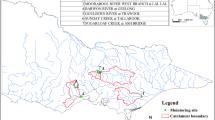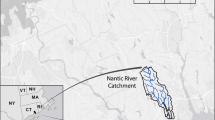Abstract
Ammonia is an important water quality variable, which in excess, can be detrimental to waterways and their ecosystems. In the Ecosystem Health Monitoring Program in South-east Queensland ammonia is monitored monthly, however, often more than 50% of the ammonia observations in Moreton Bay are below detection limit, making it difficult to draw useful inferences. In this paper a clipped Gaussian random field is used to spatially model and map the probability of detectable concentration of ammonia. The methodology is applied to the Moreton Bay samples collected in February 2005. The results suggest that for this month the oceanic impacted areas have higher probability of detectable ammonia concentration than the areas closer to the main sources of anthropogenic inputs.
Similar content being viewed by others
References
Australian Bureau of Statistics (2006). Regional population growth 2004–2005, Australia. Cat. No. 3218.0.
Bureau of Meteorology (2006). Monthly distribution of rainfall deciles — January to December 2005. Retrieved 7 September, 2006, from http://www.bom.gov.au/climate/annual_sum/2005/page8–9.pdf.
Chib, S., & Greenberg, E. (1998). Analysis of multivariate probit models. Biometrika, 85, 347–361.
Dennison, W. C., & Abal, E. G. (1999). Moreton Bay study: A scientific basis for the healthy waterways campaign. Brisbane: South East Queensland Regional Water Quality Management Strategy.
De Oliveira, V. (2000). Bayesian prediction of clipped Gaussian random fields. Computational Statistics and Data Analysis, 34, 299–314.
De Oliveira, V. (2005). Bayesian inference and prediction of Gaussian random fields based on censored data. Journal of Computational and Graphical Statistics, 14, 95–115.
Eaton, A. D., Clesceri, L. S., Rice, E. W., & Greenberg, A. E. (Eds) (2005). Standard methods for the examination of water and wastewater (21st ed.). APHA-AWWA-WPCF.
El-Shaarawi, A. H., & Esterby, S. R. (1992). Replacement of censored observations by a constant: An evaluation. Water Research, 26, 835–844.
Gibb, S. W. (2000). Ammonia. In L. M. L. Nollett (Ed.), Handbook of water analysis (pp. 223–259). New York: Marcel Dekker.
Gotway, C. A., & Stroup, W. W. (1997). A generalized linear model approach to spatial data analysis and prediction. Journal of Agricultural, Biological, and Environmental Statistics, 2, 157–178.
Goudey, R., & Laslett, G. (1999). Statistics and environmental policy: Case studies from long-term environmental monitoring data. In G. R. Bock, J. A. Goode (Eds.), Environmental statistics: Analysing data for environmental policy (pp. 144–153). Chicester: Wiley.
Grice, A., Holland, I., Jones, A., Moss A., Pantus, F., Wruck, D., et al. (2000). Annual technical report — Supporting data for the Moreton Bay and River Estuaries 2000 report card. Brisbane: Ecosystem Health Monitoring Program.
Helsel, D. R. (1990). Less than obvious: Statistical treatment of data below the detection limit. Environmental Science and Technology, 24, 1766–1774.
Miller, S. N., & Church, J. A. (1977). Simplified circulation and mixing models of Moreton Bay, Queensland. Australian Journal of Marine and Freshwater Research, 28, 23–34.
QEPA (2006). Queensland water quality guidelines 2006. Brisbane, Queensland Environmental Protection Authority.
Solow, A. R. (1986). Mapping by simple indicator kriging. Mathematical Geology, 18, 335–354.
Author information
Authors and Affiliations
Corresponding author
Rights and permissions
About this article
Cite this article
Toscas, P.J. Spatial modelling of the probability of obtaining a detectable concentration of ammonia in Moreton Bay, Australia. Environ Monit Assess 137, 379–385 (2008). https://doi.org/10.1007/s10661-007-9773-4
Received:
Accepted:
Published:
Issue Date:
DOI: https://doi.org/10.1007/s10661-007-9773-4




